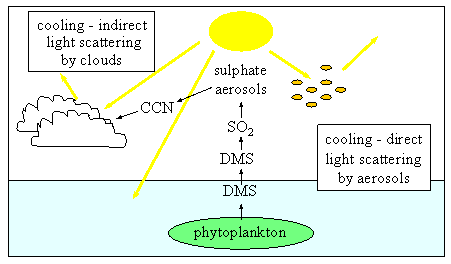|
|
 |
|
|
|
 |
| |
|
|
 |
The Oceans
Basics |
Aerosols and climate
Once dimethyl sulphide (DMS) enters the atmosphere it reacts with other chemicals to form sulphate aerosols (aerosols are simply particles or liquid droplets floating in the air). These sulphate aerosols are really important to our climate. They scatter sunlight directly back into space and can also start the formation of clouds.
|
|
|
|
|
 |
|
Both sulphur dioxide (SO2) and methane sulphonic acid (MSA - CH3SO3H) are formed when DMS is converted into sulphate aerosols. Sulphur dioxide is formed both from DMS and also during the burning of fossil fuels like coal. MSA is only formed from DMS so MSA acts as a good tracer for marine sulphur emissions into the atmosphere. Sulphur dioxide is then converted into sulphuric acid (H2SO4) so DMS plays a part in controlling how acidic the atmosphere is.
This sulphuric acid can then react with ammonia (NH3) gas, which is also produced naturally by phytoplankton, to form ammonium sulphate aerosols. Both sulphuric acid and ammonium sulphate act as cloud condensation nuclei (CCN). These are particles which attract water and provide a surface for the water to condense onto. They are needed to start the formation of clouds.
So how does DMS affect climate?
|
 |
 |
|
1. Cartoon showing the importance of marine sources of sulphur to our climate. DMS stands for dimethyl sulphide, the most important sulphur containing gas produced by some species of phytoplankton, CCN stands for cloud condensation nuclei, the aerosols needed to start cloud formation, SO2 is the gas sulphur dioxide, an intermediate species in the conversion of DMS into sulphate aerosols. Author: Lucinda Spokes.
|
Direct cooling of the Earth
Sulphate aerosols can directly absorb or scatter sunlight preventing it reaching the surface of the Earth. By preventing the sun's energy reaching us, sulphate aerosols help keep our planet cool. This cooling effect goes someway to counteract the warming effect of carbon dioxide and other greenhouse gases.
|
Indirect impact of aerosols on climate
By acting as cloud condensation nuclei and starting the formation of clouds, sulphate aerosols also have an indirect impact on our climate. Increasing the amount and whiteness of clouds over the Earth increases the albedo of our planet. Albedo is very simply defined as a measure of how much sunlight is reflected back into space. White surfaces such as clouds and ice reflect lots of sunlight back to space, whereas dark surfaces such as the ocean absorb sunlight efficiently. Since clouds reflect a lot of sunlight back into space they can cause cooling of the Earth. Over the oceans, the amount of sulphate aerosol is one of the most important factors governing the extent and type of clouds.
Some cloud types can also take up infra-red radiation from the Earth (like greenhouse gases). This effect traps heat and these clouds, therefore, cause a warming of our climate. We don't know enough about the types of clouds which form over the oceans and so we are not sure yet whether this warming effect partially or completely counteracts the cooling effect through the increase in albedo.
|
 |
 |
 |
|
2. Photograph of clouds from freefoto.com
|
|
 |
 |
|
3. Differences in albedo of different natural surfaces. Author: Lucinda Spokes, adapted from a photograph from freefoto.com.
|
|
 |
Clouds, snow and ice have a high albedo, they reflect a large amount of sunlight back into space. Water surfaces and forests have a low albedo, they absorb a lot of the sun's energy and only reflect a small amount back to space. Over the whole Earth, about 30% of incoming sunlight is reflected back to space, 50% is absorbed by the Earth and about 20% is absorbed in the atmosphere by chemicals, aerosols and clouds.
|
|
Phytoplankton are, therefore, not only the main source of acidity in marine air but are also an important source of aerosols and cloud condensation nuclei. As a result they affect the radiation budget of the Earth. At the moment we can't say accurately quite how important DMS really is to the cooling of our planet.
Have a look in the Clouds and Particles Topic for more details on how aerosols and clouds influence our climate.
About this page:
author: Dr. Lucinda Spokes - Environmental Sciences, University of East Anglia, Norwich - U.K.
scientific reviewer: Prof. Tim Jickells - Environmental Sciences, University of East Anglia, Norwich.
educational reviewers: Francis Mudge - School of Education and Professional Development, University of East Anglia, Norwich - U.K. and Trevor Leggett - Chemistry Teacher, Norwich - U.K.
last updated: 2004-06-22
|
|
 |
|







